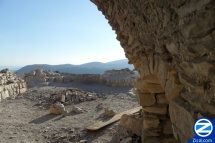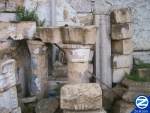Safed 1837 Earthquake
 | |
| Hebrew: | |
|---|---|
| רעידת האדמה בצפת של שנת 1837 | |
| Description: | |
| Destruction and after-effects of the 1837 earthquake in Tzfat. |
The Jewish community of Tzfat was devastated by a 1837 earthquake and a resulting landslide which killed thousands of residents and destroyed most of the city. Almost the entire Jewish Quarter was destroyed aloung with all the synagogues except the Alsheich and part of the Abuhav. In the Bat Ayn Shul, Rabbi Avraham Dov of Avritch managed to save his congregants when he predicted the earthquake moments before it took place in midst of the Mincha prayers. Most survivors left Tzfat after the earthquake but some remained, rebuilding the city aided by international donations.
Contents |
[edit] History of the Era
In the years following the 1759 earthquake, the population of Tzfat had, once again, begun to increase. A new group of immigrants, Ashkanazi “Hassidim” and “Mitnagdim” began to arrive in 1764 from Eastern European countries including Poland, Hungry, Russia, Romania and Lithuania.
![]() Read full Zissil article on the Later Ottoman Era of Safed
Read full Zissil article on the Later Ottoman Era of Safed
[edit] Earthquake
On January 1st, 1837 Tzfat experienced a tremendous earthquake, later estimated to have been a magnitude of approximately 6.8. The epicenter of the quake was the Jordan Rift Valley, east of Safed. The ground in the city was wet and unstable because of the winter rains and the earthquake created a landslide on the mountainside city, which caused most of the deaths and damage. Estimates of the dead range from 2000 to 4000 people. Most of the damage occurred in the Jewish quarter because its style of building was not as sturdy as that of the Arabs. The entire Jewish quarter was destroyed. Survivors spent days trying to dig out their families and friends who had been buried underground.
[edit] Synagogues
The Alsheich synagogue, which had also withstood the 1759 earthquake, did not collapse in the earthquake of 1837. Eyewitnesses noted that, aside from the Alsheich synagogue, only one wall was left standing in the Jewish quarter of Tzfat following the earthquake -- the southern wall of the Abuhav Synagogue. This was the wall that held the Torah scrolls, including a scroll written by Rabbi Abuhav in the 15th century which had also survived the 1759 earthquake. The southern wall of the Abuhav synagogue still stands today and the rest of the synagogue was rebuilt around the original wall.[edit] Avritch Bat Ayin
At the time that the earthquake occurred many men were in synagogue saying the afternoon “Mincha” prayers. Tzfat legend relates that a few moments before the earthquake struck, Rabbi Avraham Dov of Avritch, the rabbi of the Avritch - Bat Ayin synagogue, called to his followers “whoever wants to live, come and stand next to the Torah.”. The men ran to the Ark of the Torah and the entire synagogue collapsed around them, but the area where they stood remained untouched. The synagogue was rebuilt around the original area surrounding the Ark.
[edit] Rebuilding
Most Jews left Tzfat after the earthquake due to the devastation and out of fear that sooner or later another would occur. Rabbi Avraham Dov of Avaritch strongly insisted that his followers remain and made a personal vow that no major earthquake would ever again hit Tzfas.
Jewish communities throughout the world were urged to assist the rebuilding efforts. Rabbi Menachem Mendel of Shklov was extremely active in raising money to assist the earthquake’s survivors rebuild the city. Sir Moses and Lady Judith Montefiore arrived in Tzfat in 1840 and donated considerable sums of money towards rebuilding efforts.
[edit] Rebuilding the Synagogues
An Italian Jew, Yitzhak Gueta, donated funds for the rebuilding and refurbishment of four Safed synagogues following the 1837 earthquake. Thanks to the funds that he donated, the ARI Ashkanazi synagogue, the ARI Sepharadi synagogue, the Abuhav synagogue and the Yosef Caro synagogue were reconstructed in the years after the earthquake.
| ||||||||||||||


